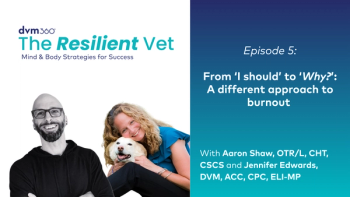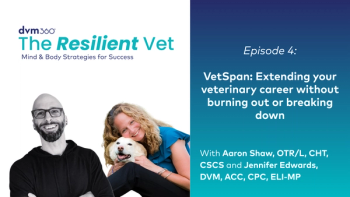
Strength of heart
You're the heart of your hospital. Making changes to get fit, eat healthy, and work smart will take courage and resolve, but we know you've got it in you.
IT CAN TAKE A CRISIS TO COMPEL PEOPLE TO CHANGE. And it often comes down to the heart. The lifeblood of your practice pumps right through you. A clinic full of happy patients, grateful clients, and dedicated team members get their inspiration and loyalty directly from you—but they won't if you don't take care of yourself, especially your own heart. Consider the fictional but all-too-common case of Janet Smith, DVM.
Dr. Smith has neglected her family and health for years in order to fulfill her self-imposed obligations to her profession. Now, at age 47, she finds herself staring at the ceiling of an intensive care unit after suffering a mild heart attack. She vows to turn things around this time. She'll change her diet, exercise regularly, and spend more time relaxing with her family. She'll take control of her schedule and make sure she and her team leave the clinic on time. She'll stop working 60 hours a week and doing paperwork every Sunday morning. She won't carry the guilt imposed on her by clients who demand too much. She says she's ready. It's time to change who she is.
The problem is, the odds are stacked against her. According to Dr. Edward Miller, dean of the medical school at Johns Hopkins University, 90 percent of patients who undergo coronary-artery bypass grafting haven't changed their lifestyle two years later.
The bottom line: Good health for all
The challenge of change isn't limited to huge lifestyle alterations. Doctors often find themselves resisting change as well when it comes to their protocols, medications, and technologies. We often resort to an "if it ain't broke, don't fix it" mentality. But just because something isn't broken doesn't mean it can't be improved. Change is a vital component of any healthy entity (whether a business or a person). When it stops changing, it stops living.
Why is this? Why don't people make changes even when their lives or businesses hang in the balance? We all know why. It's hard.
But I don't feel better
One of the most powerful drugs used to treat heart disease is a small pill taken once a day: a statin. But the June 2002 issue of the American Journal of Cardiology reported the following results of a massive study: Of 37,000 patients receiving statins, nearly all patients took the drug during the first two months. A year later, only 20 percent to 33 percent were taking the statin, even though it had been prescribed to them for the rest of their lives. For many, this proved to be a fatal mistake. Even former President Bill Clinton stopped taking his statin and ended up undergoing quadruple bypass surgery. What could possibly be easier than popping a pill a day?
Real-life example: Control the clinic clock
One of the reasons people in the study stopped taking their statin was that they didn't feel anything. You don't feel healthier or stronger on this medication. You don't feel the waxy cholesterol plaque disappearing. You feel fine and decide the tiny pills aren't worth the bother. If you're lucky like President Clinton, in a couple of years you'll be recovering with a six-inch scar to remind you to take your pill. If you're not so lucky, you won't need to worry about taking any pills—ever.
If we won't take a little pill once a day, it goes without saying that other life changes are even harder. We know that 60-hour workweeks, stress-filled days, and an unhealthy diet aren't good for us. The problem is, we continue to let our environment direct us instead of taking control of our environment. We feel powerless and accept that "this is the way things are." But when we abandon the ability to control our lives and work, we stop controlling our destiny.
Science says change can happen
Before you convince yourself that you're destined to be in the 90 percent of patients who don't change after heart surgery or, according to the National Institutes for Health, one of the 97 percent of individuals who lose weight and fail to keep it off for at least five years, let's look at how change is possible.
Real-life example: Uncover hidden motivations
First, the brain. For more than 100 years, scientists and neurologists thought the brain was fixed and unchangeable by adulthood, so they ignored neurological rehabilitation. Why try to work with stroke victims if their brain damage was permanent? Changing the brain chemistry associated with certain psychiatric diseases such as obsessive-compulsive disorder and depression was thought to be impossible.
But scientists were wrong. At the end of the 20th century, the concept of neuroplasticity—the idea that the brain could heal, change, and "rewire" itself—emerged, and successful therapies and treatments are still being developed.
Many adults think their behaviors, attitudes, and even intelligence are fixed. The truth is, we possess an incredible ability to change our behaviors and mental abilities, and neuroscience proves it. In Train Your Mind, Change Your Brain (Ballantine, 2007), author Sharon Begley describes emerging science that suggests we may be able to physically alter our brains simply by directing our thoughts. In laboratory studies performed on Buddhist monks, brain-imaging studies revealed that meditation alters and enhances blood flow and brain development in targeted areas. Simply through the act of thinking, neurons and blood vessels are measurably changed. No one knows the limits or potential advantages of this information, but it clearly demonstrates that each one of us can change our minds in profound ways.
Real-life example: Find a friend
Time is on your side
If you accept this modern science of changing brains, let's try a practical example and see if I can change your mind. Many doctors believe they can't control their appointment schedules. The tradition of providing "convenience at all costs" extracts a heavy toll on the well-being of the entire team. In many practices, late nights, burnout, and high employee turnover are the norm. Your appointment schedule, however, is something you do control. Simply create boundaries and stick to them. If you want to leave earlier in the evening, stop taking appointments a half-hour earlier. Sure, you'll still take the occasional emergency, but the bigger issue is, how will you handle the inconvenienced client who demands to be seen at 5:30 p.m. with an itching dog? You have the power to change. Will you?
Why don't we change?
When it comes to medicine and science, doctors believe the facts should compel people to change. If only it were that simple. Thousands of scientific studies prove that eating a healthy diet, exercising daily, and reducing stress helps people live the best possible life. But the majority of Americans do the exact opposite, despite the daily barrage of expert advice on how to live healthier. Does this sound like the effect of our constant barrage on some owners who won't change their pets' lifestyle?
Real-life example: Have no fear
After doctors rationally inform us using logic, and that doesn't prompt change, they often resort to tactic number two: fear. They try to frighten people into changing. There's nothing scarier than death, it seems, so they tell patients to "do this or you may die." That works for a few months, but it's too much to think about death every single day. Pretty soon, our mental defense mechanisms kick in, and we push the thought of death away and return to old habits. If fear doesn't work for 90 percent of heart surgery patients, it sure won't work when people are trying to lose 20 pounds or when they're trying to change their behavior to help their pets lose a few.
When truth and fright fail, doctors often resort to tactic number three: authority. Doctors and veterinarians believe their position as a trusted authority is powerful enough to change people. By saying, "I'm your doctor and I'm telling you what you should do," they believe they'll drive change in patients. But even the nation's top cardiologists couldn't persuade Bill Clinton to continue taking his Zocor.
These three tactics often fail because psychological self-defenses protect us from feelings of anxiety and powerlessness. Without them, we would be constantly evaluating risks and avoiding almost all interactions, since they could be harmful. These "ego defenses," as Freud called them, help us make progress, ignore empty threats, and take risks. We banish bad news from our conscious state and focus on the positive.
However, these defenses have a downside. Heart disease patients stop thinking about how their disease can kill them. Pet owners brush their dog's teeth for a few days after they learn about the dangers of periodontal disease, but they quit as soon as the fear is forgotten (it's most likely tucked away next to their doctor's recommendation to exercise, eat right, and get more sleep). Our minds simply can't be reminded all the time that something is harmful. So while some denial gets us through the day, denial that hurts long-term progress is our enemy and must be confronted in a positive way if we are to achieve sustainable change.
Starter list: 3 steps to lasting change
We also fear change when it comes to our business practices. We fear that if we experiment with our success formula, we won't be able to reset it if we make a mistake. We fear that our clients won't love us if we stop seeing appointments after 4:30 p.m. or increase our prices. We worry our staff will revolt if we raise our expectations. We become intimidated by new medications and protocols and technologies that threaten the status quo. As a result, we become set in our ways and slowly we forget how to change. As Dr. Dean Ornish says, "People don't resist change; they resist being changed."
How can we change?
In the early 1990s, Dr. Ornish knew the odds of his heart patients changing their lives after heart surgery: nine to one against. But he thought he could do better. In 1993, he took 194 patients who suffered from cardiovascular disease and put them through a lifestyle-change program to avoid bypass surgery. At the end of the one-year study, 77 percent of the patients had changed their lifestyles and avoided more surgery. That was almost eight to one in favor of change. What made the difference? Here's what he found:
A new relationship. If you want to lose weight and improve your physical fitness, you need a trainer or coach who inspires you. If you're diagnosed with heart disease, you need a doctor or a nutritionist who really believes that you can change and who will guide you through the process. You need an individual or a team whom you trust and who has the expertise to show you how to be successful.
Teaching, training, and learning. You need to repeat lessons again and again under the guidance of your teacher, mentor, or guide. Yes, repetition requires time and effort, but with adequate support and accountability, people can make it through almost anything. The key here is a feeling of connectedness. When people feel connected to others, they're more engaged and more likely to continue, despite hitting roadblocks along the way.
Reframed thinking. With his patients, Dr. Ornish replaces the "fear of death" with the "joy of living," and his team teaches them how to rediscover forgotten enjoyment. By convincing patients that they can not only live longer but feel better, Dr. Ornish is teaching people to view their disease in a positive light, as opposed to a fearful one. Once people have truly changed, they can't understand why they had trouble resisting that quart of ice cream or a pack of cigarettes. The thought of not having the time to exercise daily doesn't make sense anymore. People who have reframed their thinking now take responsibility for their change and rely less on their support team.
Look online
When should I change?
Most people wait to change until they get an emotional or physical wake-up call. The problem with waiting for a catastrophe is that not everyone gets lucky. The time to make a change is as soon as you recognize that you need to. You don't lose weight by staring at the mirror, but it can get you moving. Don't wait for a wake-up call—or a close call—to make your life the best it can be. Your family, clients, team, and profession can't afford to lose another kind heart in the fight for pet health—especially not yours.
Dr. Ernest E. Ward Jr.
Dr. Ernest E. Ward Jr., a Veterinary Economics Editorial Advisory Board member, owns Seaside Animal Clinic in Calabash, N.C. Send questions or comments to
Newsletter
From exam room tips to practice management insights, get trusted veterinary news delivered straight to your inbox—subscribe to dvm360.




